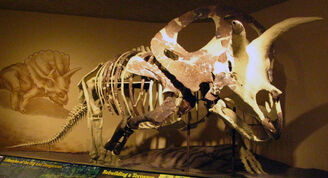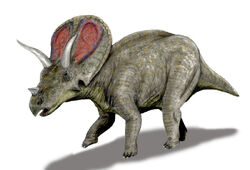Torosaurus ("perforated lizard") was a ceratopsian dinosaur that lived during the Late Cretaceous Period. Some paleontologists consider it to be a mature form of Triceratops.
Description[]
Torosaurus grew about 8,5 meters in length and may have weighed 4 to 6 tonnes.[1] It had one of the largest skulls of any known land animal, at 2.6 meters.[2]
As a large ceratopsian, Torosaurus was similar in shape to Triceratops, but had a longer frill with large fenestrae and did not have a prominent nose horn.[3]
Classification[]
Torosaurus has traditionally been classified as a chasmosaurine. Several recent analyses have showed it to be closely related to Triceratops.[4] There is one known species of Torosaurus (T. latus), with a possible second (T. utahensis).
The below cladogram by Scott Sampson and colleagues in 2010 shows the position of Torosaurus among the ceratopsians:[5]
| Ceratopsidae |
| |||||||||||||||||||||||||||||||||||||||||||||||||||||||||||||||||||||||||||||||||||||||
The Torosaurus genus is considered by some to be synonymous with that of Triceratops. For more details, see Ontogeny debate, below.
History[]

Skeleton of Torosaurus
In 1891, two ceratopsian skulls with holes in their frills were discovered in the Lance Formation of Wyoming by fossil collector John Bell Hatcher. His employer, the paleontologist Othniel Charles Marsh, named them Torosaurus latus.[6] Marsh also described another species, T. gladius, but it is today considered synonymous with T. latus.
The name Torosaurus is often mistranslated as "bull lizard", from the Latin taurus. In fact, the name probably means "perforated lizard" (from the Greek toreo), referencing the fenestrae present in the animal's frill.[7] Marsh never specifically explained the meaning of the name Torosaurus during his description, which caused the confusion.
Another possible species was originally described as Arrhinoceratops utahensis by Charles Gilmore in 1946.[8] It was reclassified as Torosaurus in 1976 by Douglas Lawson.[9] It is currently uncertain as to whether it should be regarded as a species of Torosaurus or a separate genus.[10]
It has been observed that specimens of Torosaurus are uncommon in the fossil record; Triceratops is much more abundant.
Ontogeny debate[]
In 2009, John Scanella hypothesized that Triceratops was in fact the juvenile form of Torosaurus.[11] He and his mentor Jack Horner published a paper in 2010 that concluded the two genera were indeed synonymous, and due to the rules of zoological nomenclature the name Triceratops would take priority and be used as the correct name. One of the main pieces of evidence they used to determine this was the fact that specimens of Triceratops have thinner areas in their frills that correspond in location to the holes in the frill of Torosaurus. Scannella and Horner interpreted that the holes fully appeared in the animal's frill once it reached sexual maturity. They also cited the supposed ceratopsian genus Nedoceratops to be a transitional form between the solid-frilled Triceratops and the holed-frilled Torosaurus. Their theory has been informally dubbed the "toromorph" hypothesis.[10]
Scannella and Horner's conclusions have not been accepted by all scientists, however. For example, in 2011 Andrew Farke found that several features present in Nedoceratops meant that it was in fact a distinct genus. He also interpreted the thin areas of bone on the frill of Triceratops to be muscle attachment points, and not slowly emerging holes, which would be inconsistent with what is known about the developmental history of Triceratops.[12] Several subsequent studies have also found Torosaurus and Triceratops to be distinct genera.[13]
Paleobiology[]
Diet[]
Like other ceratopsians, Torosaurus was a herbivore.[14]
In popular culture[]
Torosaurus appeared in the sixth episode of the BBC television documentary Walking with Dinosaurs, where it was portrayed as a social animal.
References[]
- ↑ Holtz, Thomas R. Jr. (2011) Dinosaurs: The Most Complete, Up-to-Date Encyclopedia for Dinosaur Lovers of All Ages, Winter 2010 Appendix.
- ↑ Lull, R.S., 1933, A revision of the Ceratopsia or horned dinosaurs, Memoirs of the Peabody Museum of Natural History 3(3): 1-175
- ↑ Longrich, N. R and Field, D. J. (2012). "Torosaurus is not Triceratops: Ontogeny in chasmosaurine ceratopsids as a case study in dinosaur taxonomy". PLoS ONE 7 (2): e32623. Bibcode:2012PLoSO...7E2623L. doi:10.1371/journal.pone.0032623. PMC 3290593. PMID 22393425.
- ↑ Farke, A. A. "Cranial osteology and phylogenetic relationships of the chasmosaurine ceratopsid Torosaurus latus", pp. 235-257. In K. Carpenter (ed.). Horns and Beaks: Ceratopsian and Ornithopod Dinosaurs. Indiana Univ. Press (Bloomington), 2006.
- ↑ Scott D. Sampson, Mark A. Loewen, Andrew A. Farke, Eric M. Roberts, Catherine A. Forster, Joshua A. Smith, and Alan A. Titus (2010). "New Horned Dinosaurs from Utah Provide Evidence for Intracontinental Dinosaur Endimism". PLoS ONE. 5 5 (9): e12292. doi:10.1371/journal.pone.0012292. PMC 2929175. PMID 20877459.
- ↑ O.C. Marsh, 1891, "Notice of new vertebrate fossils", The American Journal of Science, series 3 42: 265-269
- ↑ Dodson, P. (1996). The Horned Dinosaurs. Princeton University Press, Princeton, New Jersey, pp. xiv-346
- ↑ C.W. Gilmore, 1946, "Reptilian fauna of the North Horn Formation of central Utah", United States Department of the Interior Geological Survey Professional Paper 210-C: 29-53
- ↑ D.A. Lawson, 1976, "Tyrannosaurus and Torosaurus, Maestrichtian dinosaurs from Trans-Pecos, Texas", Journal of Paleontology 50(1): 158-164
- ↑ 10.0 10.1 Scannella, J. and Horner, J.R. (2010). "Torosaurus Marsh, 1891, is Triceratops Marsh, 1889 (Ceratopsidae: Chasmosaurinae): synonymy through ontogeny ." Journal of Vertebrate Paleontology, 30(4): 1157 - 1168. doi:10.1080/02724634.2010.483632
- ↑ Scannella J., 2009, "And then there was one: synonymy consequences of Triceratops cranial ontogeny", Journal of Vertebrate Paleontology 29: 177A
- ↑ Farke, A. A. (2011) "Anatomy and taxonomic status of the chasmosaurine ceratopsid Nedoceratops hatcheri from the Upper Cretaceous Lance Formation of Wyoming, U.S.A.." PLoS ONE 6 (1): e16196. doi:10.1371/journal.pone.0016196
- ↑ Maiorino L., Farke A.A., Kotsakis T., Piras P.,2013, "Is Torosaurus Triceratops? Geometric Morphometric Evidence of Late Maastrichtian Ceratopsid Dinosaurs", PLoS ONE 8(11): e81608. doi:10.1371/journal.pone.0081608
- ↑ Sampson, S. D., 2001, Speculations on the socioecology of Ceratopsid dinosaurs (Orinthischia: Neoceratopsia): In: Mesozoic Vertebrate Life, edited by Tanke, D. H., and Carpenter, K., Indiana University Press, pp. 263–276.
